2011 NISSAN NOTE seat adjustment
[x] Cancel search: seat adjustmentPage 5 of 235
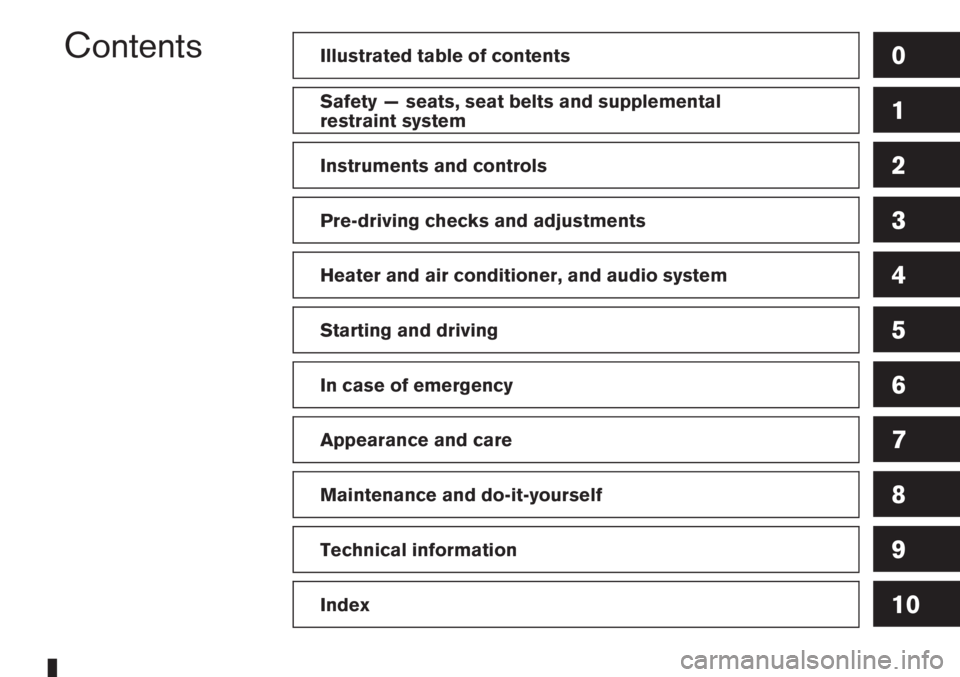
ContentsIllustrated table of contents0
Safety — seats, seat belts and supplemental
restraint system1
Instruments and controls2
Pre-driving checks and adjustments3
Heater and air conditioner, and audio system4
Starting and driving5
In case of emergency6
Appearance and care7
Maintenance and do-it-yourself8
Technical information9
Index10
Page 20 of 235
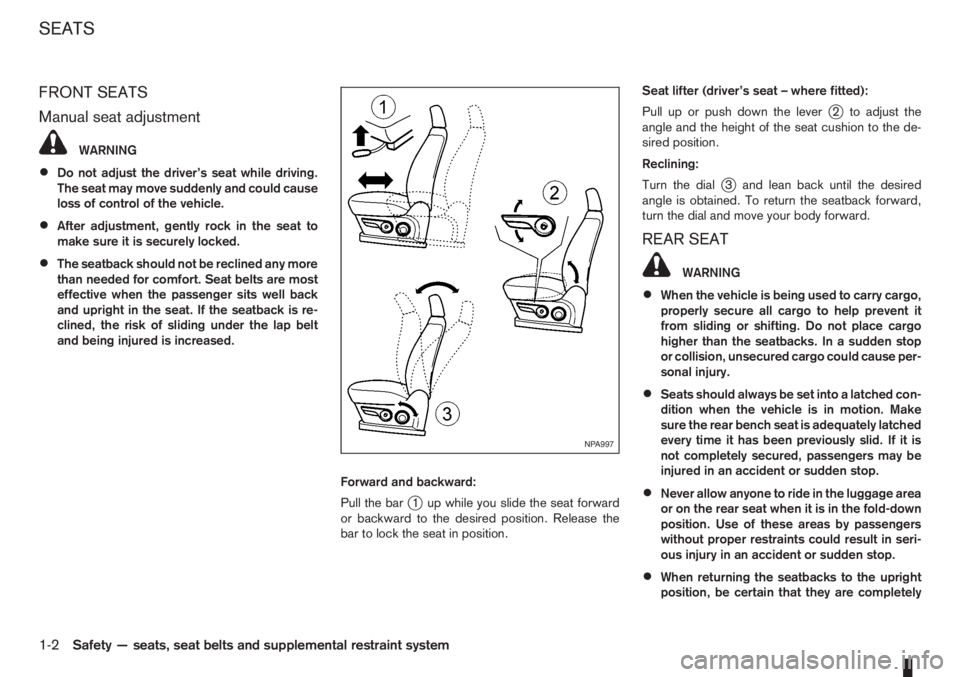
FRONT SEATS
Manual seat adjustment
WARNING
•Do not adjust the driver’s seat while driving.
The seat may move suddenly and could cause
loss of control of the vehicle.
•After adjustment, gently rock in the seat to
make sure it is securely locked.
•The seatback should not be reclined any more
than needed for comfort. Seat belts are most
effective when the passenger sits well back
and upright in the seat. If the seatback is re-
clined, the risk of sliding under the lap belt
and being injured is increased.
Forward and backward:
Pull the bar
j1 up while you slide the seat forward
or backward to the desired position. Release the
bar to lock the seat in position.Seat lifter (driver’s seat – where fitted):
Pull up or push down the lever
j2 to adjust the
angle and the height of the seat cushion to the de-
sired position.
Reclining:
Turn the dial
j3 and lean back until the desired
angle is obtained. To return the seatback forward,
turn the dial and move your body forward.
REAR SEAT
WARNING
•When the vehicle is being used to carry cargo,
properly secure all cargo to help prevent it
from sliding or shifting. Do not place cargo
higher than the seatbacks. In a sudden stop
or collision, unsecured cargo could cause per-
sonal injury.
•Seats should always be set into a latched con-
dition when the vehicle is in motion. Make
sure the rear bench seat is adequately latched
every time it has been previously slid. If it is
not completely secured, passengers may be
injured in an accident or sudden stop.
•Never allow anyone to ride in the luggage area
or on the rear seat when it is in the fold-down
position. Use of these areas by passengers
without proper restraints could result in seri-
ous injury in an accident or sudden stop.
•When returning the seatbacks to the upright
position, be certain that they are completely
NPA997
SEATS
1-2Safety — seats, seat belts and supplemental restraint system
Page 21 of 235
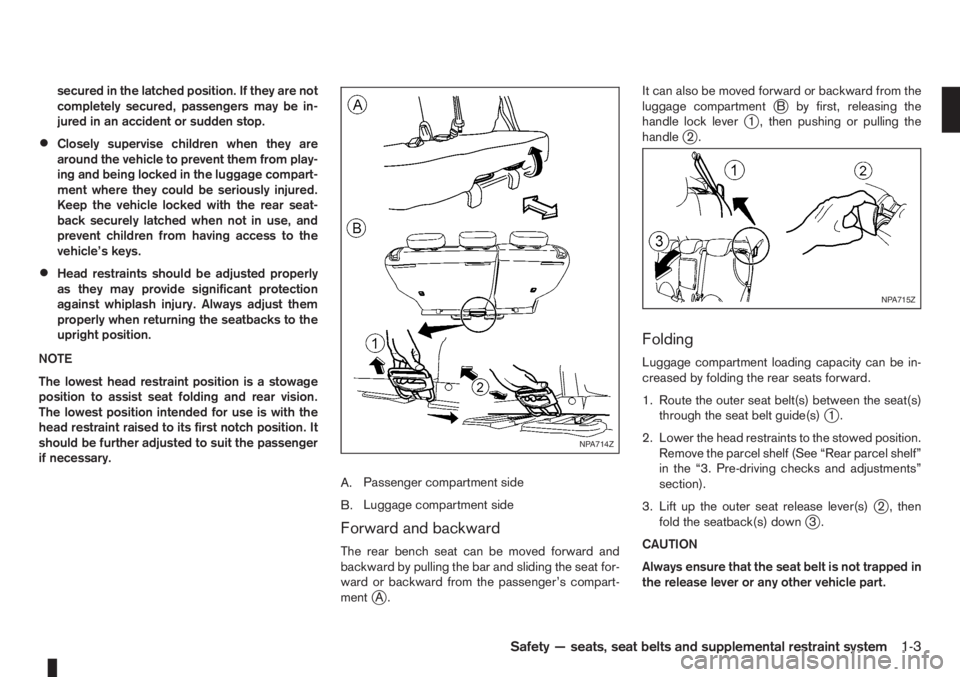
secured in the latched position. If they are not
completely secured, passengers may be in-
jured in an accident or sudden stop.
•Closely supervise children when they are
around the vehicle to prevent them from play-
ing and being locked in the luggage compart-
ment where they could be seriously injured.
Keep the vehicle locked with the rear seat-
back securely latched when not in use, and
prevent children from having access to the
vehicle’s keys.
•Head restraints should be adjusted properly
as they may provide significant protection
against whiplash injury. Always adjust them
properly when returning the seatbacks to the
upright position.
NOTE
The lowest head restraint position is a stowage
position to assist seat folding and rear vision.
The lowest position intended for use is with the
head restraint raised to its first notch position. It
should be further adjusted to suit the passenger
if necessary.
A.Passenger compartment side
B.Luggage compartment side
Forward and backward
The rear bench seat can be moved forward and
backward by pulling the bar and sliding the seat for-
ward or backward from the passenger’s compart-
ment
jA.It can also be moved forward or backward from the
luggage compartment
jB by first, releasing the
handle lock leverj1 , then pushing or pulling the
handlej2.
Folding
Luggage compartment loading capacity can be in-
creased by folding the rear seats forward.
1. Route the outer seat belt(s) between the seat(s)
through the seat belt guide(s)
j1.
2. Lower the head restraints to the stowed position.
Remove the parcel shelf (See “Rear parcel shelf”
in the “3. Pre-driving checks and adjustments”
section).
3. Lift up the outer seat release lever(s)
j2 , then
fold the seatback(s) downj3.
CAUTION
Always ensure that the seat belt is not trapped in
the release lever or any other vehicle part.
NPA714Z
NPA715Z
Safety — seats, seat belts and supplemental restraint system1-3
Page 22 of 235
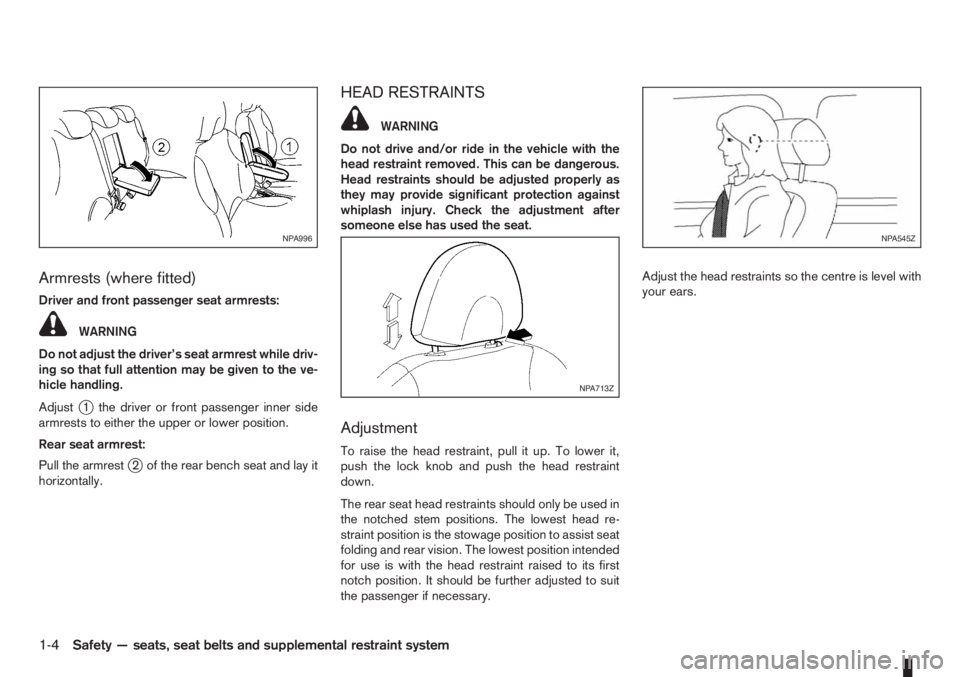
Armrests (where fitted)
Driver and front passenger seat armrests:
WARNING
Do not adjust the driver’s seat armrest while driv-
ing so that full attention may be given to the ve-
hicle handling.
Adjust
j1 the driver or front passenger inner side
armrests to either the upper or lower position.
Rear seat armrest:
Pull the armrest
j2 of the rear bench seat and lay it
horizontally.
HEAD RESTRAINTS
WARNING
Do not drive and/or ride in the vehicle with the
head restraint removed. This can be dangerous.
Head restraints should be adjusted properly as
they may provide significant protection against
whiplash injury. Check the adjustment after
someone else has used the seat.
Adjustment
To raise the head restraint, pull it up. To lower it,
push the lock knob and push the head restraint
down.
The rear seat head restraints should only be used in
the notched stem positions. The lowest head re-
straint position is the stowage position to assist seat
folding and rear vision. The lowest position intended
for use is with the head restraint raised to its first
notch position. It should be further adjusted to suit
the passenger if necessary.Adjust the head restraints so the centre is level with
your ears.
NPA996
NPA713Z
NPA545Z
1-4Safety — seats, seat belts and supplemental restraint system
Page 26 of 235
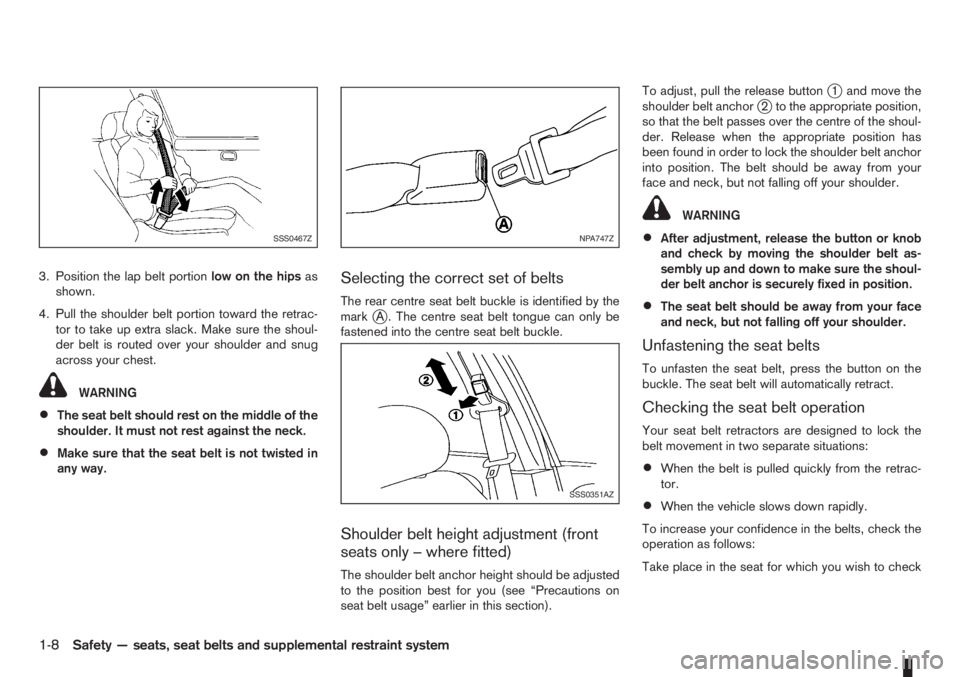
3. Position the lap belt portionlow on the hipsas
shown.
4. Pull the shoulder belt portion toward the retrac-
tor to take up extra slack. Make sure the shoul-
der belt is routed over your shoulder and snug
across your chest.
WARNING
•The seat belt should rest on the middle of the
shoulder. It must not rest against the neck.
•Make sure that the seat belt is not twisted in
any way.
Selecting the correct set of belts
The rear centre seat belt buckle is identified by the
markjA . The centre seat belt tongue can only be
fastened into the centre seat belt buckle.
Shoulder belt height adjustment (front
seats only – where fitted)
The shoulder belt anchor height should be adjusted
to the position best for you (see “Precautions on
seat belt usage” earlier in this section).To adjust, pull the release button
j1 and move the
shoulder belt anchorj2 to the appropriate position,
so that the belt passes over the centre of the shoul-
der. Release when the appropriate position has
been found in order to lock the shoulder belt anchor
into position. The belt should be away from your
face and neck, but not falling off your shoulder.
WARNING
•After adjustment, release the button or knob
and check by moving the shoulder belt as-
sembly up and down to make sure the shoul-
der belt anchor is securely fixed in position.
•The seat belt should be away from your face
and neck, but not falling off your shoulder.
Unfastening the seat belts
To unfasten the seat belt, press the button on the
buckle. The seat belt will automatically retract.
Checking the seat belt operation
Your seat belt retractors are designed to lock the
belt movement in two separate situations:
•When the belt is pulled quickly from the retrac-
tor.
•When the vehicle slows down rapidly.
To increase your confidence in the belts, check the
operation as follows:
Take place in the seat for which you wish to check
SSS0467ZNPA747Z
SSS0351AZ
1-8Safety — seats, seat belts and supplemental restraint system
Page 34 of 235
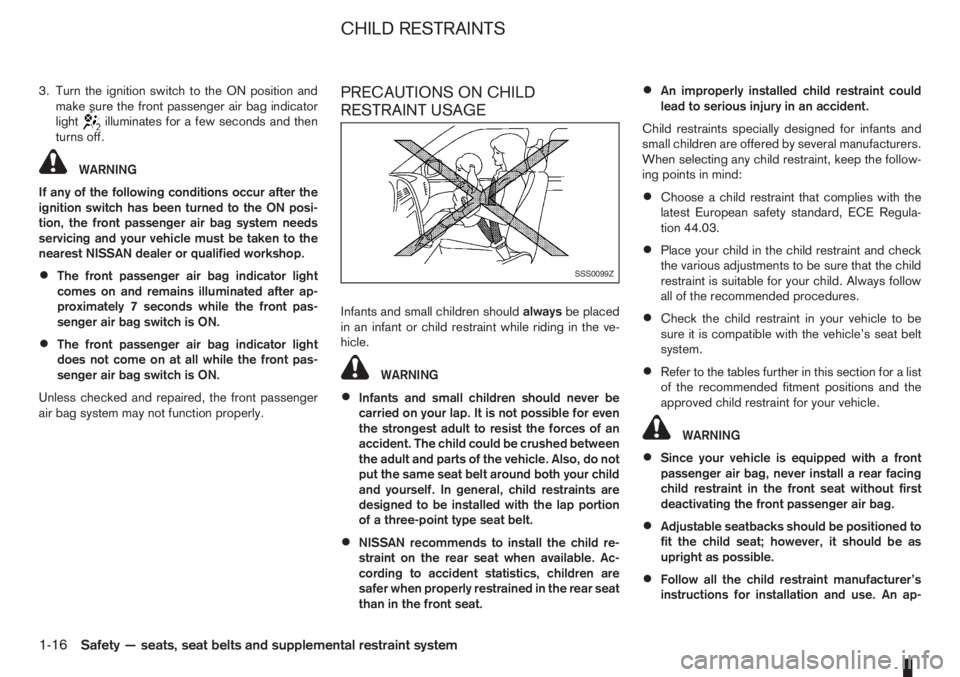
3. Turn the ignition switch to the ON position and
make sure the front passenger air bag indicator
light
illuminates for a few seconds and then
turns off.
WARNING
If any of the following conditions occur after the
ignition switch has been turned to the ON posi-
tion, the front passenger air bag system needs
servicing and your vehicle must be taken to the
nearest NISSAN dealer or qualified workshop.
•The front passenger air bag indicator light
comes on and remains illuminated after ap-
proximately 7 seconds while the front pas-
senger air bag switch is ON.
•The front passenger air bag indicator light
does not come on at all while the front pas-
senger air bag switch is ON.
Unless checked and repaired, the front passenger
air bag system may not function properly.
PRECAUTIONS ON CHILD
RESTRAINT USAGE
Infants and small children shouldalwaysbe placed
in an infant or child restraint while riding in the ve-
hicle.
WARNING
•Infants and small children should never be
carried on your lap. It is not possible for even
the strongest adult to resist the forces of an
accident. The child could be crushed between
the adult and parts of the vehicle. Also, do not
put the same seat belt around both your child
and yourself. In general, child restraints are
designed to be installed with the lap portion
of a three-point type seat belt.
•NISSAN recommends to install the child re-
straint on the rear seat when available. Ac-
cording to accident statistics, children are
safer when properly restrained in the rear seat
than in the front seat.
•An improperly installed child restraint could
lead to serious injury in an accident.
Child restraints specially designed for infants and
small children are offered by several manufacturers.
When selecting any child restraint, keep the follow-
ing points in mind:
•Choose a child restraint that complies with the
latest European safety standard, ECE Regula-
tion 44.03.
•Place your child in the child restraint and check
the various adjustments to be sure that the child
restraint is suitable for your child. Always follow
all of the recommended procedures.
•Check the child restraint in your vehicle to be
sure it is compatible with the vehicle’s seat belt
system.
•Refer to the tables further in this section for a list
of the recommended fitment positions and the
approved child restraint for your vehicle.
WARNING
•Since your vehicle is equipped with a front
passenger air bag, never install a rear facing
child restraint in the front seat without first
deactivating the front passenger air bag.
•Adjustable seatbacks should be positioned to
fit the child seat; however, it should be as
upright as possible.
•Follow all the child restraint manufacturer’s
instructions for installation and use. An ap-
SSS0099Z
CHILD RESTRAINTS
1-16Safety — seats, seat belts and supplemental restraint system
Page 84 of 235
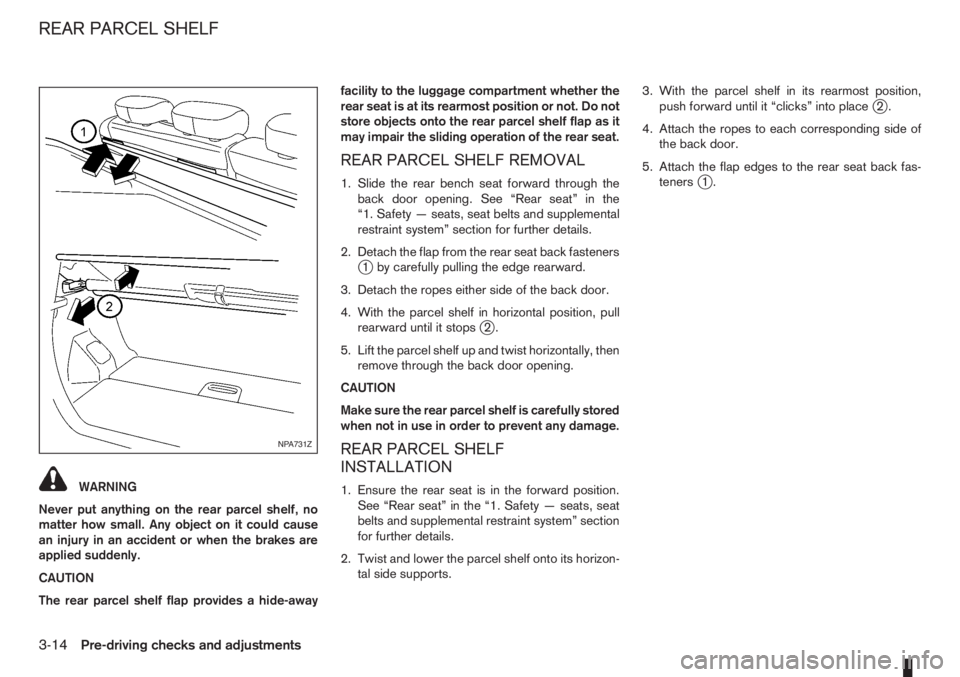
WARNING
Never put anything on the rear parcel shelf, no
matter how small. Any object on it could cause
an injury in an accident or when the brakes are
applied suddenly.
CAUTION
The rear parcel shelf flap provides a hide-awayfacility to the luggage compartment whether the
rear seat is at its rearmost position or not. Do not
store objects onto the rear parcel shelf flap as it
may impair the sliding operation of the rear seat.
REAR PARCEL SHELF REMOVAL
1. Slide the rear bench seat forward through the
back door opening. See “Rear seat” in the
“1. Safety — seats, seat belts and supplemental
restraint system” section for further details.
2. Detach the flap from the rear seat back fasteners
j1 by carefully pulling the edge rearward.
3. Detach the ropes either side of the back door.
4. With the parcel shelf in horizontal position, pull
rearward until it stops
j2.
5. Lift the parcel shelf up and twist horizontally, then
remove through the back door opening.
CAUTION
Make sure the rear parcel shelf is carefully stored
when not in use in order to prevent any damage.
REAR PARCEL SHELF
INSTALLATION
1. Ensure the rear seat is in the forward position.
See “Rear seat” in the “1. Safety — seats, seat
belts and supplemental restraint system” section
for further details.
2. Twist and lower the parcel shelf onto its horizon-
tal side supports.3. With the parcel shelf in its rearmost position,
push forward until it “clicks” into place
j2.
4. Attach the ropes to each corresponding side of
the back door.
5. Attach the flap edges to the rear seat back fas-
teners
j1.
NPA731Z
REAR PARCEL SHELF
3-14Pre-driving checks and adjustments
Page 226 of 235

Precautions
– Audio operation precautions .......................................... 4-10
– Brake precautions ......................................................... 5-27
– Child restraint usage ..................................................... 1-16
– Maintenance precautions ................................................. 8-4
– Operating precautions (trailer) ....................................... 5-24
– Precautions on cruise control system ............................. 5-19
– Towing precautions ....................................................... 6-12
– When starting and driving ................................................ 5-3
Pregnant women ................................................................... 1-7
Protect
– Protect the environment ................................................. 8-12
– Protect your vehicle from corrosion .................................. 7-5
Push-starting ....................................................................... 6-11
R
Radio
– AM-FM radio with CD player and navigation .................. 4-34
– FM AM radio with CD player ......................................... 4-23
– LW-MW-FM radio with CD player ................................. 4-16
– NATS immobilizer radio approval number ......................... 9-8
Rear parcel shelf ................................................................. 3-14
– Installation ..................................................................... 3-14
– Removal ........................................................................ 3-14
Rear seat .............................................................................. 1-2
Rear window defogger ........................................................ 2-15
Recommended SAE viscosity number ................................... 9-4
Remote
– Steering wheel i switch .................................................... 2-3
Remote control system (integrated keyfob) ............................ 3-3
Repairing flat tyre .................................................................. 6-7
Running-in schedule .............................................................. 5-2S
Safety
– Active head restraints ...................................................... 1-5
– Child safety ..................................................................... 1-7
– Child safety rear door lock ............................................... 3-8
– ISOFIX system .............................................................. 1-22
– Safety chains (Trailer) .................................................... 5-25
– Top tether strap for child restraint .................................. 1-23
Seat
– Active head restraints ...................................................... 1-5
– Front seats – Adjustment ................................................. 1-2
– Head restraints ................................................................ 1-4
– Rear seat ......................................................................... 1-2
– Seat heating .................................................................. 2-19
– Seats .............................................................................. 1-2
Seat belt
– Child safety ..................................................................... 1-7
– Injured persons ............................................................... 1-7
– Pre-tensioner seat belt system ......................................... 1-9
– Precautions on seat belt usage ........................................ 1-6
– Pregnant women ............................................................. 1-7
– Seat belt maintenance ..................................................... 1-9
– Seat belt warning lights ................................................... 1-5
– Seat belts ................................................................. 1-5, 7-4
– Three-point type seat belts ............................................... 1-7
Security system ..................................................................... 3-9
– NISSAN Anti-Theft System (NATS) ................................. 3-9
Servicing air conditioner ........................................................ 4-7
Snow chains ....................................................................... 8-30
Spare tyre ............................................................................. 6-2
Spark plugs (Petrol engine models) ..................................... 8-18
Speed limiter ....................................................................... 5-15
Speed limiter operations ...................................................... 5-16
– Vehicles with diesel engine ............................................ 5-17
– Vehicles with petrol engine ............................................ 5-16
10-6Index